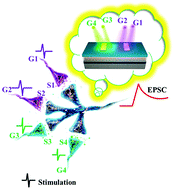A multi-input light-stimulated synaptic transistor for complex neuromorphic computing†
Abstract
Multi-input synaptic devices that can imitate multi-synaptic connection and integration in the human brain are crucial for the construction of ideal brain-like computing systems with parallelism, low power consumption, and robustness. However, the current multi-input synaptic devices are all based on electrical operation, bringing undesirable signal redundancy, huge device scale, and large energy consumption. Here, for the first time, a multi-input synaptic device utilizing light as an input signal was realized to overcome the drawbacks induced by electrical operation. The essential synaptic functions including synaptic short-term plasticity (STP), long-term plasticity (LTP), and paired-pulse facilitation (PPF) were demonstrated in an energy-efficient way (picojoule magnitude) and synaptic superlinear/sublinear integrations were successfully imitated in our device. Moreover, the “AND”/“OR” light logic functions and the light-stimulated Pavlov classical conditioning experiment with dogs were realized based on the synaptic integration behaviors. Interestingly, owing to the persistent photoconductivity (PPC) effect of the semiconductor layer and synaptic behaviors induced by perovskite quantum dot (QD) absorption, the device could implement detection, acquisition, analysis, and storage of light signals, enabling its potential application in fog computing. This powerful device offers the potential for building an artificial intelligence neural network with miniaturization, low energy consumption, and superior connectivity between discrete computing modules.



 Please wait while we load your content...
Please wait while we load your content...